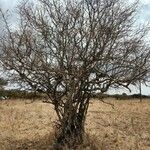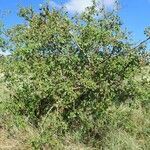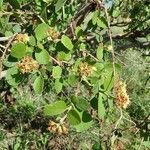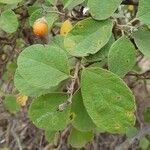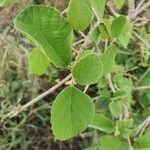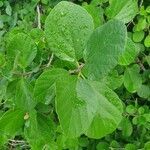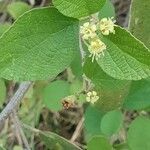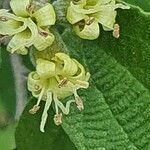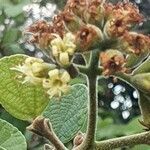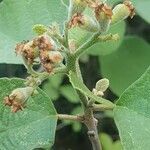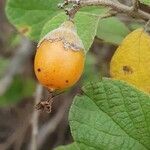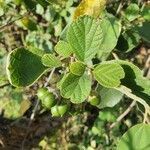Much-branched spreading shrub or small tree branched from the base, 1.5-8(-15) m tall; crown usually spreading; bark rather rough, grey, but sometimes smooth and flaking in long strips; branches longitudinally striate, with ± ferruginous indumentum and often velvety when young, later glabrescent, with short internodes and prominent reniform or semicircular petiole-scars. Leaves alternate; blades elliptic, ovate, obovate or ± rounded, (1-)2.5-8(-11 or-13 on coppice) cm long, (1-)2-9 cm wide, rounded, apiculate or often emarginate at the apex, less often acute, cuneate to rounded at the base, entire, denticulate or rarely distinctly repand-dentate, rugose and mostly very scabrid above with minute tubercle-based hairs together with sparse branched hairs, densely ± softly white pubescent beneath; venation reticulate beneath, often reddish; petiole (0.5-)1.2-5 cm long, brownish tomentose. Flowers fragrant, bisexual or unisexual in terminal or axillary panicles of cymes 2-6 cm long, few-flowered, the axes fulvous-tomentose; pedicels articulate at the apex, 0.2-0.8(-3) mm long. Calyx tubular-campanulate, 6-8.5 mm long, 5-8 mm wide, tomentose outside with simple and branched hairs, glabrous or sparsely pubescent inside, 3-5-lobed or sometimes ± 2-lipped or irregularly torn. Corolla greenish white to pale yellow, 1-1.2 cm wide; tube cylindric, 4-7 mm long; lobes 3-5, oblong to narrowly obovate, 3.5-5.5(-6.5) mm long, 1-2.5 mm wide, spreading. Male: filaments either 6 mm long or 2-3 mm long in what appears to be different forms; corolla and stamens 5(-6)-merous; gynoecium absent. Female and bisexual: filaments 2-3 mm long; corolla 4-5-merous; ovary ovoid, 3-3.5(-5) mm long, 1.5-1.8 mm wide, glabrous; style exserted, 6-10 mm long; stigmatic branches 3-5 mm long, recurved. Fruits yellow or orange but also reported to be olive-black to black, ovoid or obovoid, 0.9-2 cm long, 0.6-1.2 cm wide, sitting in the persistent 1 cm wide accrescent calyx, 3-4-locular but usually 1-seeded by abortion.
A shrub. It has several stems. It grows up to 6-15 m tall. The bark is blue-grey. It is fibrous and peels off in strips. The leaves are broad and oval. They are 5-8 cm long. The leaf edges are slightly toothed. The upper leaf surface is like sandpaper to touch. It is softly hairy underneath. The leaf stalks is 2 cm long. The small branches, leaf stalks and flower stalks are covered with dense rusty hairs. The flowers are pale yellow. They have a sharp smell. They occur in clusters near the ends of branches. Each flower in the shape of a tube and is about 1 cm across. The fruit are oval and pointed. They are yellow-orange and soft when ripe. They are 2 cm long and held in a case of leaves covering about one third of their length. The pulp of the fruit is edible. There is a single seed inside.
Leaves alternate; petiole 0.5–2.5(3.5) cm. long, flat or slightly canaliculate above; lamina 3–10(14) x 2–8(10) cm., ovate, obovate or subcircular, sometimes elliptic, rough and sometimes also with some stellate or variously branched hairs above, densely pubescent to rough and often with stellate or branched hairs mainly on the nerves below, obtuse or rounded and sometimes shortly acuminate at apex, obtuse to truncate, rarely acute at base, with subentire, crenate to crenate-serrate margins, leathery and with 3–5 secondary nerves on each side of the midrib, the lower ones basal or nearly so and stronger than the other.
Small tree or shrub, up to 5(-7) m high. Leaves pinnately or 3-nerved from base, densely covered with short, rigid excrescences above; ovate, obovate or sub-circular, sometimes elliptic; densely pubescent to rough and often with stellate or branched hairs mainly on nerves below; margins subentire, crenate to crenate-serrate. Calyx not ridged or prominently nerved; densely scabrous or roughish and tawny-tomentose. Flowers yellow.
Stamens (or staminodes) as many as the corolla lobes, inserted at the corolla-throat; filaments 1.5–4.0 mm. long, slender, glabrous or with a few long hairs at the base; anthers 1.5–2.0 mm. long on the male flowers and c. 1 mm. long on the female and male ones, but on the latter ones often almost sterile.
Fruit 15–22 x 10–15 mm., ovoid or ellipsoid, apiculate, glabrous, orange when ripe, surrounded at the lower third by the widely enlarged campanulate calyx; mesocarp fleshy; pyrene c. 10 x 7 mm., usually deeply cleft at the apex, ± circular in cut across, 1–3-seeded.
Ovary c. 2 mm. long, ovoid-conical, glabrous, on the male flowers vestigial; style 7–9 mm. in total length, first-forked at 1.5–3.5 mm. and with stigmatic branches 2.5–5.0 mm. long, linear.
Shrub or small tree up to 5(7) m. high; branchlets angular, usually rough and minutely fulvous-tomentose when young with stellate, ± branched or simple hairs, glabrescent.
Calyx 6–8 mm. long, narrowly campanulate or infundibuliform, irregularly 3–5-toothed, rough to minutely fulvous-tomentose outside, sparsely pubescent to glabrous inside.
Cymes arranged in usually few-flowered terminal or very rarely axillary panicles 1.5–5(7) cm. long; rhachis and branches minutely fulvous-tomentose.
Corolla yellow, glabrous; tube 4–7 mm. long, cylindrical; lobes (4)5(6), 4–6(7) x 1-2 mm., oblong to narrowly obovate, rounded at apex, reflexed.
Flowers polygamous on pedicels up to 2 mm. long.
